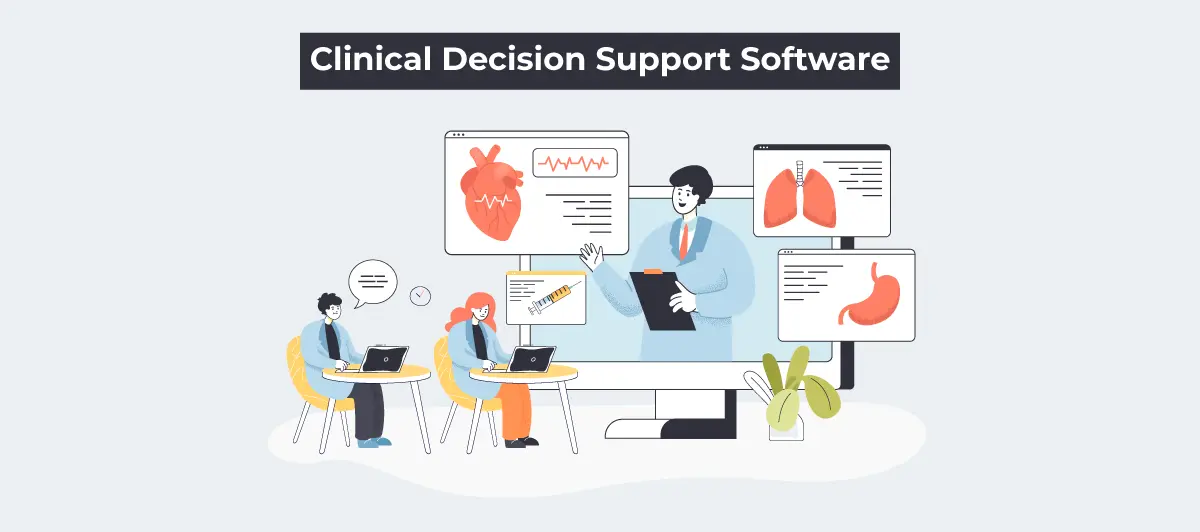What is the Clinical Decision support software? Benefits, Features and More
Quick Summary: A clinical desicion support software (CDSS) empowers healthcare professionals with real-time insights, aiding in diagnosis and treatment decisions. Its benefits include enhanced patient care, reduced errors, and improved efficiency, making it an invaluable tool in modern healthcare.
Introduction
There are a huge number of decisions that an individual makes daily. The majority of these choices are for food and clothing that are less important and only matter a little. But things take a round turn when you enter making choices in the healthcare industry. Here, one must make decisions that might save or destroy life. The consequences of a wrong decision can lead to a graveyard. Hence, a healthcare provider must go through innumerable factors to select the best treatment. They have to do it all super fast and under very heavy pressure.
But thankfully, they can seek help from computers for this task. To be more specific, they can seek help from clinic management system development. It is becoming a valuable digital asset for healthcare providers as the amount of data increases with the pressure of delivering the best care. These systems integrate with electronic health records to streamline clinical workflow and operations. Are you eager to learn more about clinical decision support software and their function? This text will help you out.
What are clinical decision support software?
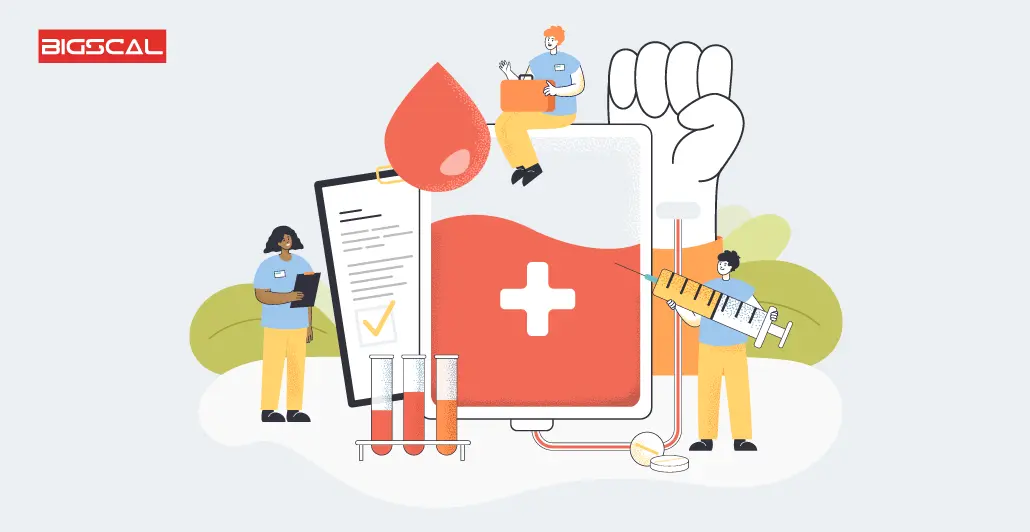
Clinical data management software is one of the tools that helps all experts, such as clinical staff, administrative people, patients, and others. It provides them with information in a filtered manner, along with a specific person or scenario.
This system provides the best quality care and lessens chances of errors or any problematic stuff. CDS can help all the team members become more efficient in their process.
According to HealthIT.gov, It must have different tools that help in decision-making. These tools might include computerized alerts that can be helpful for both professionals and patients. Other tools include clinical guidelines, condition-specific order sets, specific patient data records, document templates, support for diagnosis and much more.
Although these guidelines and support frameworks for diagnostics need not be digital, it’s better to leverage the company’s digital assets. The real definition of CDS in this changing world is focusing on health IT applications, modules, or analytics.
But for experts in the EHR 2nd stage, the meaning of Clinical decision support systems is the functionality that enhances the foundation of EHR to facilitate the people in processes with more specific data. Thien it filters data with intelligence and organizes it at necessary times. Hence, it could lead to better health care.
As per the National Coordinator, defining clinical decision support software precisely is impossible. But it also encourages the development of different tools that can help in health management, provide precise medicine, best care, patient safety and better efficiencies.
Know that CDS is not specifically for doctors and nurses but can be more helpful for staff, patients and even other caregivers, as per the CMS eHealth University.
There are instances where practices like reminders like a return to the clinic are available in EHRs that remind staff to notify patients for routine screening or notify them about upcoming appointments. It can also help prepare for meetings like fasting, outside lab work, etc. It can also turn into brief medication instructions, tips for managing home, or dietary guidelines.
Lastly, as per CMS clinical practice guidelines, decision support software might have a system, workflow, or process that helps in delivering:
- Correct information, such as guidance based on evidence or response to any necessity.
- To the concerned authorities, such as the care team, even patients
- With the right path, such as EHR, mobile or any portal
- In the right manner, like order sets, flow sheets, lists and dashboards
- In the proper points in workflow for better decisions and actions
Hospitals tend to adopt and apply quickly to empower better care.
What are applications of clinical decision support systems?
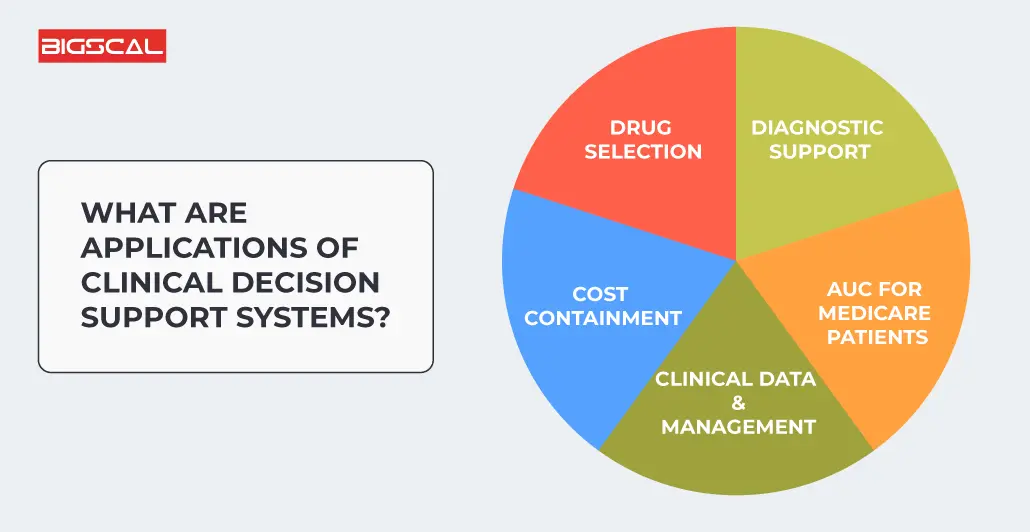
It is likely for a human brain to commit many errors, mainly when working with a huge amount of data and in a stress-prone environment such as the healthcare sector. But now computers and technology can take away that tough task of handling tons of data and conducting plenty of comparisons to make data as short as possible. Clinical decision support software can help make better decisions from too many to too few.
Drug selection
As per statistics, almost 8,00 people die due to medication problems every year. Along with that, there is a huge amount of people who find problems due to inappropriate medicines, wrong doses and incompatible drugs. Hence, this can complicate and enhance costs of about 40 billion annually.
Thankfully, these errors are mostly at initial stages like ordering or prescribing. Hence, it is easy to identify and prevent this before it causes major harm. It is where decision support systems come into play. They can cut down factors like distractions that lead to about 75% of errors.
Seeking help with critical data like age, weight, allergies, and current prescriptions can help CDSS automatically handle the following tasks.
Drug allergy testing.
Clinical desicion support software will help cross-check the medication they have ordered with the patient data reports. It checks it against allergies, assesses the chances of reactions and gives alerts.
Basic data on ideal dosage:
As per data errors in the accurate dosage result in 60% of prescription mistakes. But you can easily overcome this with decision support software. Simply put, this software will generate a list per patient that provides the ideal dosage for a medication. Hence, it will save the time a doctor might spend selecting the dosage. It might also provide alerts when the perfect dosage limit exceeds.
Checking for duplicate therapy:
A duplicate treatment is an incident where the same active ingredient is given more than once. Hence, this overdose can lead to unwanted effects. The feature of clinical decision-making software will ensure patient safety by comparing new drug ingredients to the ones in the patient profile. Hence, if it matches, it will show an alert.
Checking for drug interactions:
Drugs might interact with certain substances that cannot give the expected results. Hence, drug-disease interactions as per the clinical documentation, this system will compare interactions of new drugs with:
- Other drugs that the patient already uses
- Food stuff and other liquid intakes
- Herbal products
- Alcohol
- Test results
- pregnancy and lactation
- a patient’s disease that leads to decreased efficiency
Diagnostic support
Clinical decision support software for identifying diseases is known as diagnostic decision support systems. People might also know it as a medical diagnosis system. This system compares the patient information against the existing database and generates a probable diagnosis list.
One example of a DDSS solution is using deep learning for imaging. Hence, it would particularly focus on particular areas of problem, such as lung problems or a certain kind of cancer. These tools function similarly to an extra pair of eyes that provide better suggestions and alerts. Hence, rather than giving conclusions, you get directions. Bigscal’s article about decision support systems health care can help you understand its role better.
Cost containment
When decision support software is integrated with CPOE, it might help you decrease treatment costs. It would rather suggest low-cost drugs and can even pinpoint the duplication in tests. Many studies have shown that this software can save a great amount of money per year by giving an alert when there is excessive testing conducted.
Clinical data & management
Many clinics and medical institutions suggest using support software to adhere to the clinical guidelines. Just like data about drugs and diseases, one can enter the clinical rules of the hospital in the knowledge-based CDSS like IF-THEN-ELSE pieces of information. These solutions perform different tasks, prompting nurses to measure parameters per the protocols. Hence, it could help inform doctors regarding patients who don’t stick to treatment plans.
AUC for Medicare patients
AUC is the acronym for appropriate use criteria, which can help you mention when one has actually to perform that medical service. It all started in January 2020 when the Protecting Access to Medicare Act made it compulsory for American hospitals to abide by Medicare’s AUC program. It is a program for advanced imaging, such as computer tomography and MRI.
Hence, this means that before you ask a patient to go through a test, medical organizations must ensure they get in touch with a clinical decision support mechanism. With a decision from a CDS tools service provider, they will receive money for these tests.
Also, this program had educational and testing periods that didn’t employ any penalties, but its full implementation started in 2021. Hence, when all the challenges related to technologies were solved, this initiative was helpful for providers and patients by improving the quality of care and reducing the costs of tests.
Although there is a particular reason for implementing clinical decision support systems, they are made to eliminate costs for better patient outcomes. Clinical research suggests this tool is expected to enhance the future and avoid adverse events.
What are the components of a Clinical decision support system?
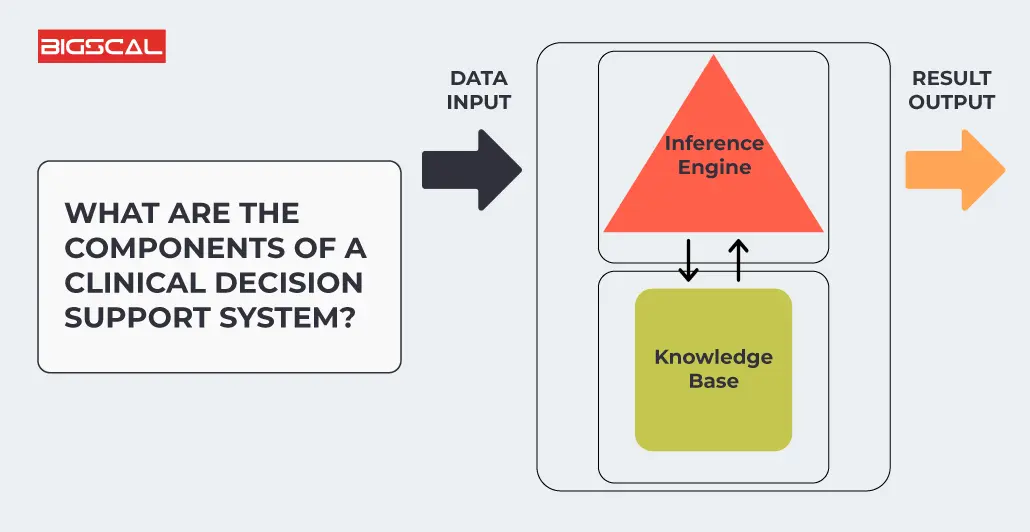
A typical Clinical decision support software has three elements. These elements are a data management layer, inference engine, and user interface.
The data management layer will bring together a clinical database that will consist of a data management layer combines information about diseases, their diagnoses, lab reports, and patient data. It will also have a knowledge base as if-then rules or machine learning models.
An inference engine, also known as a processing layer, can apply rules and databases as a knowledge base to ensure that patient data is available. Hence, the you can see result through the user interface layer. This layer can be mobile, application, electronic health records or text alerts.
Hence, within the same structure, clinical decision support software comes into two different categories. These categories are knowledge-based and non-knowledge-based systems.
What is the purpose of CDSS?
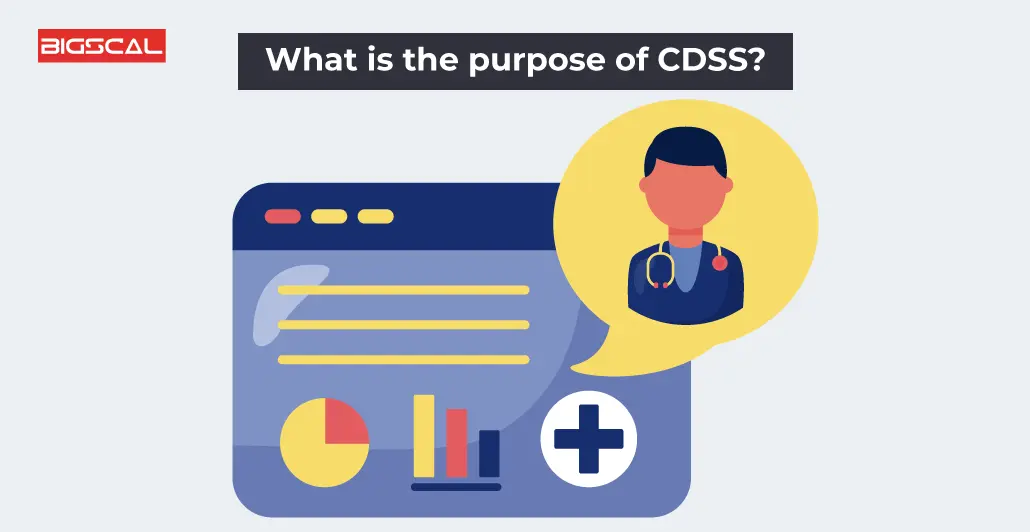
The main purpose and benefit of clinical decision support software is to help all providers, letting them analyze patients’ data and gather that information for better care and diagnosis. It is such a system that ensures the clinicians and care providers have accurate information for patients’ better care.
Clinical decision support software, for instance, can provide reminders for preventive care, alerts of any drug interaction that might occur, or inform doctors about any test their patient has to undergo. Hence, this tool can help reduce costs while boosting efficiency in clinical management.
Many providers make use of CDSS for patients when diagnosis happens in the wrong manner, skip or were given the wrong dosage of medication. These errors are into the lists and in population health management reports. These reports serve as a foundation for all improvement initiatives.
Knowledge-based VS non-knowledge-based.
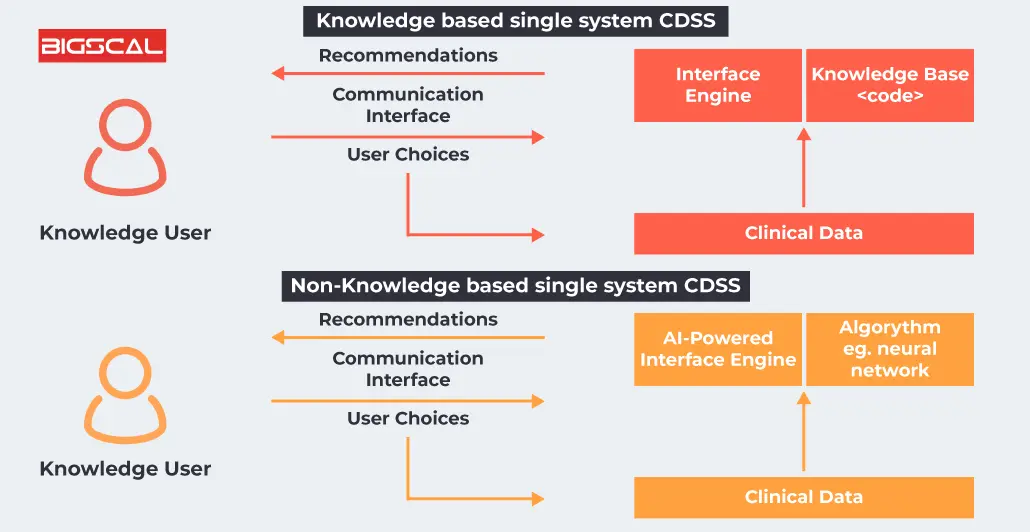
Clinical support system software is present into two categories. One of these two types is knowledge-based. It further applies these rules to patients’ data with the help of organized clinical knowledge.
Inference engine. Later, it will display the results. Most of these types of CDSS have a data repository. It is an inference engine and a communication method that might operate under rules like if-then.
For instance, if the knowledge base is trying to check drug interactions, then as per the rule, if drug A is taken, the prescription will be drug B. If so, then you must receive an alert.
However, a clinical decision support software that doesn’t have a knowledge base will rely solely on machine learning to analyze clinical data. For instance, non-knowledge-based CDSS, such as an artificial neural network, helps understand how to perform specific tasks through examples. It generally happens without any programming with if-then or task-specific rules. It analyzes different patterns present in patient data to identify the relation between symptoms and diagnosis.
How can Bigscal help with clinical support software development?
Bigscal is undoubtedly superior in the way it creates world-class products for clinical support software development with a main goal of reforming the healthcare field. Being a laboratory information software supplier, we take the efficiency and innovation very seriously. Thus, we provide our clients with bespoke software that automates clinical processes, handles a bulk amount of data, and complies with all the regulations.
It presents us not only EHR, telehealth solutions and diagnostic tools. This tool put all medical providers in one “ecosystem”. Using next generation technologies, Bigscal aims to ensure safety of the programs, appropriate interoperability, and ultimate user satisfaction. By working together we can design powerful clinical management software that will allow healthcare workers to get not the common tools but effective solutions to provide responsible patient care when the healthcare network grows.
Conclusion
Clinical Decision support systems are known to introduce clinical knowledge to caregivers that can help them enhance care and get better patient data reports. Hence, this can mend the ways of imparting health and healthcare delivery.
This tool includes clinical guidelines, drug allergy checking, drug-drug interactions and medication alerts. They have order sets that customize treatment plans per the patient’s medical history and conditions.
The main benefit of clinical decision support software in health systems is better efficiency and great quality patient care with the right health-related decisions. Hence, it could balance out the ratio between cost and benefit. Know that the outcomes should be favourable to the patients.
One such example of an existing clinical desicion support software is at a Nebraska clinic. It increases patients’ visits and seeks the help of electronic health records to know about hypertension patients. Adopting the CDS tool can enhance staff efficiency and provide favourable medical outcomes.
FAQ
What is the clinical decision support system?
Clinical Decision Support System (CDSS) is healthcare technology that assists clinical staff to utilize relevant information in making informed decisions. Thus, it leads to improved patient care and comprehension.
What are the top three clinical and decision support tools and systems?
CDSS usually are from Epic, Cerner, and Mckesson which are the well-known names. These data-driven systems help patients with advanced tools and functionality in the field of healthcare industry.
What are the three components of a CDSS?
A CDSS usually contains a knowledge base, an inference engine, and a communication interface, i.e: user interface. Via these constituents the information is collected and analyzed, to give appropriate data and updates.
What are the 5 rights of clinical decision support?
The 5 rights refer to providing individuals with the precise, action-oriented information in ways they prefer, via channels they frequent at exact times they require.
What is CDSS in healthcare?
In healthcare, CDSS means a technology system that helps healthcare providers in their decision-making process by means of suggesting relevant data found among patient information and the medical knowledge.
